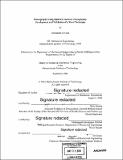| dc.contributor.advisor | Brett Bouma. | en_US |
| dc.contributor.author | Chau, Alexandra H. (Alexandra Hung), 1980- | en_US |
| dc.contributor.other | Massachusetts Institute of Technology. Department of Mechanical Engineering. | en_US |
| dc.date.accessioned | 2014-11-04T21:32:24Z | |
| dc.date.available | 2014-11-04T21:32:24Z | |
| dc.date.copyright | 2004 | en_US |
| dc.date.issued | 2004 | en_US |
| dc.identifier.uri | http://hdl.handle.net/1721.1/91380 | |
| dc.description | Thesis (S.M.)--Massachusetts Institute of Technology, Dept. of Mechanical Engineering, 2004. | en_US |
| dc.description | Includes bibliographical references (p. 161-167). | en_US |
| dc.description.abstract | Atherosclerosis is an inflammatory disease characterized by an accumulation of lipid and fibrous tissue in the arterial wall. Postmortem studies have characterized rupture-prone atherosclerotic plaques by the presence of a large lipid-rich core covered by a thin fibrous cap. Studies employing finite element analysis (FEA) based on ex vivo plaque geometry have found that most plaques rupture at sites of high circumferential stress, thus diagnosis of plaque vulnerability may be enhanced by probing the mechanical behavior of individual plaques. Elastography is a method of strain imaging in which an image sequence of the artery undergoing deformation is acquired, pixel motion is estimated between each frame, and the resulting velocity field is used to calculate strain. In this thesis, optical coherence tomography (OCT), a high-resolution optical imaging modality, is investigated as a basis for FEA and elastography of atherosclerotic plaques. FEA was performed using plaque geometries derived from both histology and OCT images of the same plaque. Patterns of mechanical stress and strain distributions computed from OCT-based models were compared with those from histology-based models, the current gold standard for FEA. The results indicate that the vascular structure and composition determined by OCT provides an adequate basis for investigating the biomechanical factors relevant to atherosclerosis. A new variational algorithm was developed for OCT elastography that improves upon the conventional algorithm by incorporating strain smoothness and incompressibility constraints into the estimation algorithm. | en_US |
| dc.description.abstract | (cont.) In simulated OCT images, the variational algorithm offers significant improvement in velocity and strain accuracy over the conventional algorithm, particularly in the presence of image noise. Polyvinyl alcohol (PVA) phantoms of homogeneous and heterogeneous elastic modulus distribution were developed for further testing of the variational algorithm. Testing with the phantoms indicated that motion- and strain-induced decorrelation between images presents a practical challenge to the implementation of OCT elastography. Analysis of the experimental results led to the identification of potential improvements to the elastography algorithm that may increase accuracy. These improvements may include relaxation of the strain smoothness constraint to incorporate strain discontinuities at boundaries of elastic modulus in heterogeneous regions, and enforcement of geometry compatibility to prevent the estimation of non-physical velocity fields. | en_US |
| dc.description.statementofresponsibility | by Alexandra H. Chau. | en_US |
| dc.format.extent | 167 p. | en_US |
| dc.language.iso | eng | en_US |
| dc.publisher | Massachusetts Institute of Technology | en_US |
| dc.rights | M.I.T. theses are protected by copyright. They may be viewed from this source for any purpose, but reproduction or distribution in any format is prohibited without written permission. See provided URL for inquiries about permission. | en_US |
| dc.rights.uri | http://dspace.mit.edu/handle/1721.1/7582 | en_US |
| dc.subject | Mechanical Engineering. | en_US |
| dc.title | Elastography using optical coherence tomography : development and validation of a novel technique | en_US |
| dc.type | Thesis | en_US |
| dc.description.degree | S.M. | en_US |
| dc.contributor.department | Massachusetts Institute of Technology. Department of Mechanical Engineering | |
| dc.identifier.oclc | 61049557 | en_US |
